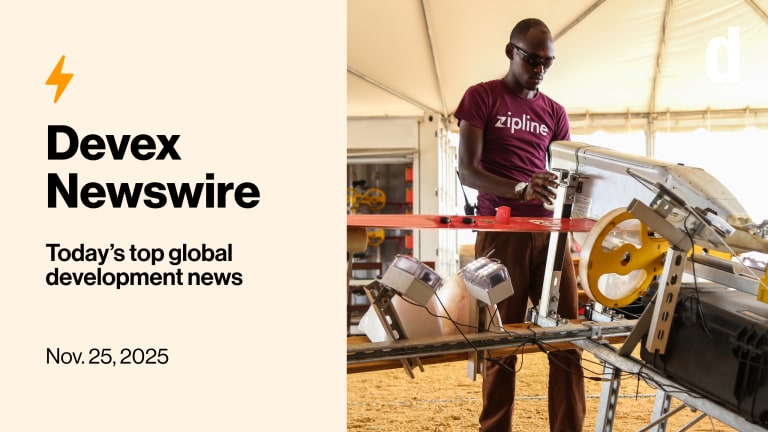As cash transfers gain favor, time for a rehaul of market assessments
The use of cash in the humanitarian sector has grown exponentially in recent years. Humanitarian actors spoke to Devex about the best practices for market assessments for these types of programs.
NAIROBI — In 2013, Typhoon Haiyan hit the Philippines, causing floods, landslides, and widespread destruction. Some 40 percent of the humanitarian response constituted cash transfers, totaling $845 million, and at least 45 agencies were involved in providing cash. But the bulk of the responders were hesitant to inject cash, worried about whether the market could absorb it. The intuition was to respond with in-kind aid first and then later transition to cash. Not every market is appropriate for cash transfers. Markets can be severely disrupted by natural disaster or conflict, creating a situation where, even if a beneficiary receives cash, they will have limited options on where to spend it — or beneficiaries may live in remote areas where functional markets are out of reach. In the case of Typhoon Haiyan, however, the region was already flush with incoming cash. The scale of the damage had prompted a massive flow of remittances into the region, instrumental in prompting market recovery in those initial days. But the humanitarian sector didn’t grasp that at the time. Instead, there were delays in market assessments — that would have shown that the market could handle the injection of cash, said Isabelle Pelly, program coordinator at the Cash Learning Partnership. “We don’t do enough quick-and-dirty market assessments and we take too long to do it,” said Pelly. “We don’t assume as a default, that markets can respond to an injection of cash — but that should be our default thinking.” The humanitarian sector conducts market assessments both to get a better read on conditions they are about to introduce cash to and to monitor conditions after it is distributed. These assessments vary in scale and scope — depending on factors such as the duration of a program and the size — and determine how deeply an organization will assess a market. Market assessments for providing cash in the humanitarian sector very much remain a work in progress. According to this year’s The State of World’s Cash Report published by CaLP, some market assessments fall short of their aims. According to the report: “Response analysis and market analysis are undertaken inconsistently within and between organization.” “The tools used for market assessment tend to focus on commodities, rather than the service markets which are of interest in sectors such as shelter, WaSH [water, sanitation, and hygiene], and education. Respondents saw a need to simplify market analysis guidance to enable wider adoption by country teams and improve decision making.” To learn more about some of the best practices in market assessments for cash programming, Devex spoke with humanitarian actors currently implementing these programs. What to examine When determining whether to use cash programming, organizations should employ a holistic approach to examine markets. This includes exploring what people are likely to purchase and making sure that these items or services are available in the market, as well as examining their susceptibility to price fluctuations. “Market monitoring needs to look at a whole basket of goods and basic needs that a household is meeting through markets every month,” said Pelly. To do that, an organization should map out the market’s players including local traders, retailers, wholesalers, and national level producers, suggested Joanna Burton, cash transfers and markets specialist at the International Committee of the Red Cross. Organizations should also follow the supply chain for an item, from its origin to market to identify blockages, according to Calum McLean, global thematic coordinator of cash and basic needs at the European Civil Protection and Humanitarian Aid Operations. Blockages could include financial barriers, such as transport or transaction costs, or physical ones, such as the potential for a road to flood. Looking at whether there is adequate access to warehousing and credit for traders is also a concern. The level of market integration should also be factored in, said McLean. “If a local market is not well integrated and is largely based on local production, then it is perhaps less resilient to changes in production and the availability of goods, as opposed to a market that is well-connected to a larger supply chain,” he added. Market collusion can also be a factor when only a small number of traders dominate a market and decide to hike up the price, said McLean. Social norms need to be addressed, including looking at gender, said Pelly. Organizations should be aware, for instance, if there is a checkpoint that prevents women from entering a certain marketplace or restricts their access. This could also include discrimination against certain ethnicities that could hamper market access. “You would want to pick that out in a market analysis and monitor it over time,” said Pelly. Rural areas can be seen as tricky environments to implement cash programming. This is because long distances might limit people’s access to markets. That distance should be assessed to ensure it’s a practical solution for beneficiaries, said Lili Mohiddin, regional cash and markets adviser for the Eastern Africa & Yemen regional office at the Norwegian Refugee Council. Areas where markets are severely disrupted because of conflict can also be inappropriate for cash interventions. Burton agreed: “Markets change extremely rapidly, even without a crisis. There’s always new competitors coming in, new traders.” The attitude of governments and the policies they enact around cash distribution is also key to decision making. For example, the Ethiopian government is not very supportive of multi-purpose cash in certain locations because of concerns about the supply chain, said Mohiddin. But it tends to be OK with cash interventions that are small and focused. Larger scale cash interventions are a harder sell, because of concerns over the aggregate impact. “Governments saying no is a very difficult hurdle to jump,” said Mohiddin. It is also key to understand that what people say they need isn’t always what they will buy; people’s needs change on a daily basis. “Needs can be seasonal, they can be temporal,” said Mohiddin. “We need of finding a way of being more dynamic in the way that we capture people’s needs and potential purchases.” In any analysis, coordination with other organizations using cash programming is crucial. This helps to evaluate the aggregate impact of the cash programs. “There is a lot to consider,” said Mohiddin. “Whether all of these areas are being looked at or not, is another question.” Ongoing scrutiny After cash programming is implemented, there is an ongoing need to monitor markets. These types of analyses have traditionally focused on monitoring the prices of one commodity to watch whether the prices have gone up or down. But the sector needs to expand that mindset to look at the broader picture, humanitarian actors say. “Cash interventions have tended to focus most on prices because that’s what donors have been most worried about,” said Mohiddin. A broader examination would include examining whether the number, type, size, and gender of traders has changed, said Mohiddin. Supply chains should also be examined to see whether they have gotten longer or shorter, in addition to whether competition in the market, the policy environment, or social norms have changed. “We tend to be so focused on the beneficiaries that we give the cash to and the prices of the items of the goods and services that they purchase, that we don’t look more broadly,” said Mohiddin. But prices are still important. Inflation can not only have a negative impact on the beneficiaries that receive the cash but can also have a negative impact on host populations who also have to pay those prices, said McLean. Quality of products available should be taken into account, said Pelly. For example, materials for building latrines might stay the same price, but the quality of the materials might deteriorate over time. In cases such as that, it might no longer be appropriate to provide cash. Instead, a mixed modality response might make sense, such as providing cash for some of the needs and in-kind for others. “That’s the challenge that a lot of agencies are trying to grapple with right now from an operational perspective, to make sure they basically have the pipelines functional for both cash assistance and in-kind assistance,” said Pelly. “Market situations and other factors change over time.” “As much as possible, existing secondary information should be drawn on, and then the next step is figuring out what is missing and what needs to be collected through primary data.” --— Isabelle Pelly, program coordinator at the Cash Learning Partnership The tools Context is important in moving forward with these analyses. The depth of the market analysis depends on the scale of humanitarian need and the scale of the potential response, said Pelly. CaLP has a series of tools available for organizations to use that give guidance on market analyses. The primary difference between them is their level of depth. Some are more suited to look at particular sectors, or commodities, whereas others look cross-sectoral, including to service markets. The tools also differ in terms of whether they are more appropriate in a rapid-onset crisis or one that is protracted. “There is no standard way in which you would analyze the data, but there are a number of different factors you would want to look at,” said Pelly. The default instinct in the sector is to go straight into primary data collection, but a lot can be collected from secondary data, said Pelly. This includes already available information, such as from the government, the Famine Early Warning Systems Network, or previous market analyses. “As much as possible, existing secondary information should be drawn on, and then the next step is figuring out what is missing and what needs to be collected through primary data,” said Pelly. Sources of collecting this information can include household or community-level interviews, working with the local chamber of commerce or other market associations, and speaking with individual traders throughout the supply chain. “We kind of try and interview and talk to people at all levels of the chain,” said Burton. Quantitative data is not always possible or desirable in humanitarian settings where the environment is constantly changing, said Pelly. Because of this, it is more important to understand changes in market functionality. Market analysis has traditionally been led by program teams within humanitarian organizations rather than logistic and supply chain teams, said Pelly. A shift away from this is starting to happen in some organizations. “There is a lot of information that is already being collected and analyzed by logistic functions around import tariffs, around border closings, and warehousing, etc., that can be extremely valuable in producing a broader understanding of a market system,” said Pelly. Traditionally, much of these analyses have been focused on the gaps between people’s needs and what they have access to. “What is more valuable is to understand how functional the market is, how have these shocks affected it, and what are the likely trends going to be in the market going forward,” said Pelly. In terms of trends, especially in areas of recurring crises, it can be useful to look at the past, she added. Market actors can typically provide enough information about how the market will respond, and how long it will take, and what factors in the past have accelerated or delayed recovery. “If you are providing a little bit of cash for basic needs, in a fairly buoyant economy that has been used in the past with no adverse effects noted, then your need for analysis is not as great as say, if you target a large number of people in a fairly rural context where there have been issues in the past, or cash has not been used before,” said Mohiddin. The is also a Markets in Crisis group that brings together actors to discuss these topics. Cash as the default In the majority of situations, experts say introducing cash does not harm market systems but often strengthens markets “I have worked for 14 years on cash transfer programming. I find it very rare to find markets not functioning,” said Burton. Distributing in-kind aid can actually do more to prevent markets from recovering in some circumstances than cash. In situations where cash is not an appropriate response, organizations such as NRC are increasingly taking the position that when cash is not feasible, especially when there are issues around the supply chain, it will work to remedy these situations so that cash can be used in the future. But despite the resiliency of markets, it’s also important not to make assumptions about markets and follow-through with these market assessments alone, said Burton. Supporting markets more broadly Market traders are seen as key partners in successful cash programming. Because of this, organizations should talk to traders in advance of a cash distribution so that they can respond, said McLean. In this process, organizations need to take into account questions such as how long the traders need to make adjustments and whether they can access the right infrastructure in order to make the supply ready for when beneficiaries have the cash, said Mohiddin. But beyond just tipping market traders off to the impending cash flow, the humanitarian sector can also strengthen markets through market support programming. This could include providing assistance to traders such as helping them re-establish their business, which could ultimately increase the level of access to affordable goods in the market. It could also mean working to ensure that there is access to credit for traders. “Can we actually support traders in the marketplace? What is the issue? Is there a physical blockage? Is it that the bridge is down and they can’t move things through? Is it that their warehouses have been damaged and they’re not able to move goods through?” said Burton. “Where there’s no food in the market, we try to understand why there’s no food,” she said. The problem is that this type of programming is not always an easy sell to donors. “Being able to demonstrate that causality, build the evidence and the case for it with donors is still a challenge,” said Pelly. NRC, for example, is working in Somaliland to improve road infrastructure for sellers. “We would like donors to be far more accepting of other forms of market-based programs,” said Mohiddin. “This includes working directly with traders or financial service providers that work with traders.” These types of market analysis are not just for cash programming, humanitarian actors say. They are important to any sort of humanitarian response. “It should be a standard part of any response analysis process,” said Pelly. “In-kind programming should be perhaps more sensitive to the damage that it can do to markets.”
NAIROBI — In 2013, Typhoon Haiyan hit the Philippines, causing floods, landslides, and widespread destruction. Some 40 percent of the humanitarian response constituted cash transfers, totaling $845 million, and at least 45 agencies were involved in providing cash.
But the bulk of the responders were hesitant to inject cash, worried about whether the market could absorb it. The intuition was to respond with in-kind aid first and then later transition to cash.
Not every market is appropriate for cash transfers. Markets can be severely disrupted by natural disaster or conflict, creating a situation where, even if a beneficiary receives cash, they will have limited options on where to spend it — or beneficiaries may live in remote areas where functional markets are out of reach.
This story is forDevex Promembers
Unlock this story now with a 15-day free trial of Devex Pro.
With a Devex Pro subscription you'll get access to deeper analysis and exclusive insights from our reporters and analysts.
Start my free trialRequest a group subscription Printing articles to share with others is a breach of our terms and conditions and copyright policy. Please use the sharing options on the left side of the article. Devex Pro members may share up to 10 articles per month using the Pro share tool ( ).
Sara Jerving is a Senior Reporter at Devex, where she covers global health. Her work has appeared in The New York Times, the Los Angeles Times, The Wall Street Journal, VICE News, and Bloomberg News among others. Sara holds a master's degree from Columbia University Graduate School of Journalism where she was a Lorana Sullivan fellow. She was a finalist for One World Media's Digital Media Award in 2021; a finalist for the Livingston Award for Young Journalists in 2018; and she was part of a VICE News Tonight on HBO team that received an Emmy nomination in 2018. She received the Philip Greer Memorial Award from Columbia University Graduate School of Journalism in 2014.








